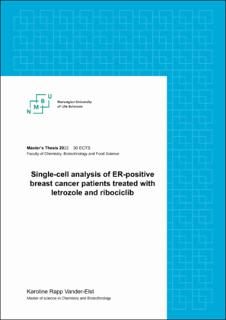| dc.contributor.advisor | Tekpli, Xavier | |
| dc.contributor.advisor | Carlsen, Harald | |
| dc.contributor.author | Vander-Elst, Karoline Rapp | |
| dc.date.accessioned | 2022-08-17T11:50:26Z | |
| dc.date.available | 2022-08-17T11:50:26Z | |
| dc.date.issued | 2022 | |
| dc.identifier.uri | https://hdl.handle.net/11250/3012350 | |
| dc.description.abstract | Breast cancer is the most widespread cancer in the world, accounting for 25% of all female cancers. There is a high inter- and intra-tumor heterogeneity in breast cancer which makes it challenging to optimize the treatment for the individual patient. In recent years, the role of immune infiltration in tumor carcinogenesis and pathophysiology has been increasingly recognized. It has therefore become a priority to understand the interactions and cooperation between immune and cancer cells. Despite a thorough attempt to match treatment options with clinicopathological features such as histological classification, grade, stage, biomarkers, molecular subtypes, and intrinsic subtypes, many patients show resistance to treatment. One attempt to overcome treatment resistance is the emergence of combinatorial treatment, meaning treating patients with two drugs at the same time.
CDK4/6 inhibitors are anti-cancer drugs which prohibits cell growth and is shown to have promising results in combination with aromatase inhibitors for breast cancer patients with hormone receptor positive disease. This drug combination is not yet approved in Norway as standard neoadjuvant treatment. The NeoLetRib clinical trial facilitates the access to the combinations of aromatase and CDK4/6 inhibitor to patients. The study also gives the opportunity to investigate potential biomarkers for more personalized treatment, novel predictive biomarkers and assess how the tumor microenvironment changes during treatment.
Single cell analysis is the method we used to capture each cells transcriptome in the tumor microenvironment. We performed scRNA-seq of breast cancer biopsies from patients enrolled in the clinical trial NeoLetRib before the neoadjuvant treatment and after 21 days. This study shows that five cellular subtypes including Tregs, and four monocyte subtypes had a significant proportional change. These cell types have been associated with the promotion of a proinflammatory microenvironment and may be associated with tumor progression. | en_US |
| dc.language.iso | eng | en_US |
| dc.publisher | Norwegian University of Life Sciences, Ås | en_US |
| dc.rights | Attribution-NonCommercial-NoDerivatives 4.0 Internasjonal | * |
| dc.rights.uri | http://creativecommons.org/licenses/by-nc-nd/4.0/deed.no | * |
| dc.title | Single-cell analysis of ER-positive breast cancer treated with letrozole and ribociclib | en_US |
| dc.type | Master thesis | en_US |
| dc.description.localcode | M-KB | en_US |

